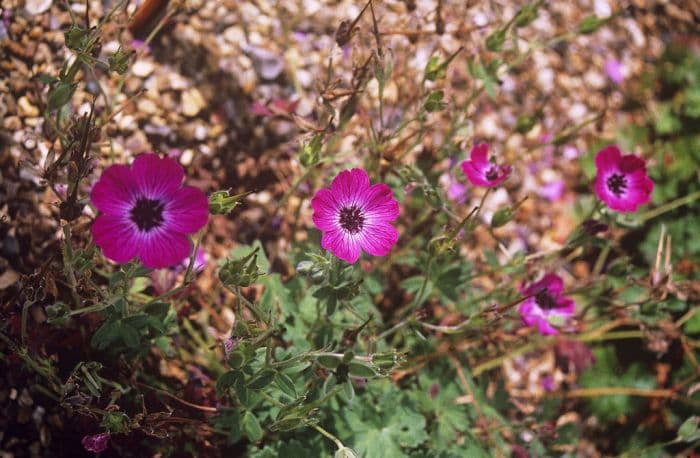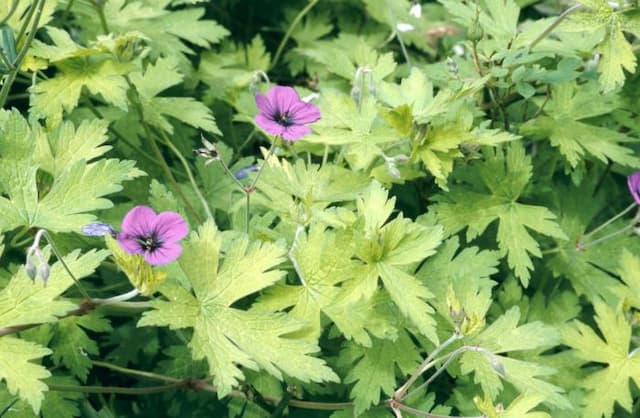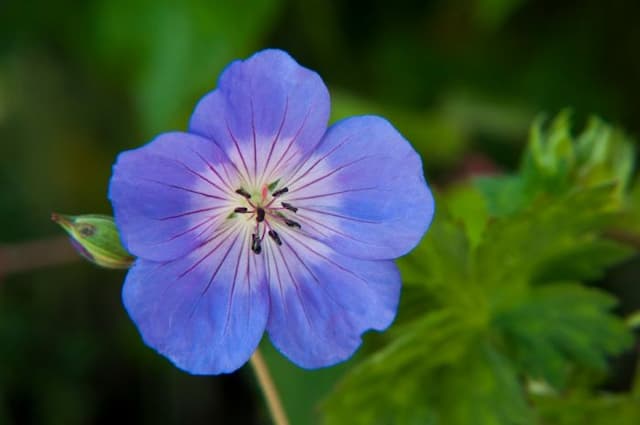Gypsy Geranium Geranium × lindavicum 'Gypsy'

ABOUT
The Geranium 'Gypsy' is an ornamental plant with a striking appearance known for its vibrant blooms. It typically showcases a profusion of flowers that possess a rich color palette, often featuring shades of pink or purple. The petals usually exhibit a rounded form which can sometimes appear slightly ruffled, giving each bloom a dynamic and inviting presence. The blossoms are borne atop a lush and dense foliage that provides a beautiful contrast with its green leaves. These leaves are not merely a backdrop but also contribute to the overall attractiveness of the plant, as they often have a deeply lobed pattern and may display interesting textures. The plant, as a whole, exudes a cottage garden charm, making it a favorite among gardeners seeking to add a splash of color and a touch of traditional beauty to their outdoor spaces.
About this plant
 Names
NamesFamily
Geraniaceae
Synonyms
Cranesbill, Hardy Geranium
Common names
Geranium × lindavicum 'Gypsy'.
 Toxicity
ToxicityTo humans
Geraniums are generally considered non-toxic to humans. While they are not intended for consumption, accidental ingestion typically doesn't lead to serious poisoning. However, some individuals may experience mild gastrointestinal upset, such as nausea or diarrhea, after ingesting parts of the plant. Contact with the skin can sometimes cause dermatitis in sensitive individuals.
To pets
Geraniums are known to be toxic to pets, particularly to dogs, cats, and horses. If a pet ingests any part of a geranium, they might exhibit symptoms such as vomiting, anorexia, depression, and dermatitis. In rarer cases, ingestion could potentially lead to more severe consequences such as ataxia or hypothermia if consumed in large enough quantities. Pet owners should prevent their animals from ingesting geraniums and consult a veterinarian if they suspect their pet has eaten any part of the plant.
 Characteristics
CharacteristicsLife cycle
Perennials
Foliage type
Deciduous
Color of leaves
Green
Flower color
Pink
Height
1-2 feet (30-60 cm)
Spread
1-2 feet (30-60 cm)
Plant type
Herb
Hardiness zones
5
Native area
Hybrid
Benefits
 General Benefits
General Benefits- Aesthetic Appeal: Adds vibrant color and visual interest to gardens and landscapes with its blossoming flowers.
- Easy to Grow: Known for being a hardy plant that is easy to care for, making it suitable for both experienced and novice gardeners.
- Pollinator Friendly: Attracts bees, butterflies, and other beneficial pollinators, supporting local ecosystems.
- Drought Tolerance: Once established, it has a good tolerance for dry conditions, requiring less frequent watering.
- Versatility: Can be planted in borders, containers, or as ground cover, fitting various garden designs and styles.
- Long Blooming Season: Offers a long period of flowering usually from late spring to early fall, providing continuous color.
- Deer and Rabbit Resistant: Less appealing to deer and rabbits, which can help prevent them from damaging other more susceptible plants in the garden.
 Medical Properties
Medical PropertiesThis plant is not used for medical purposes.
 Air-purifying Qualities
Air-purifying QualitiesThis plant is not specifically known for air purifying qualities.
 Other Uses
Other Uses- Art and Craft Projects: The colorful leaves and flowers of the Geranium can be pressed and used in creating natural art pieces or for decorating homemade cards and scrapbooks.
- Geranium Essential Oil: While not a primary use, the oil extracted from certain species of geranium can be used in aromatherapy for relaxation or to create home-made perfumes.
- Dye for Fabrics: The petals of the Geranium can be used to create a natural dye for fabrics, giving them a beautiful and subtle color.
- Garden Design: Geraniums are often used in landscape design to provide color and texture, as they can be easily shaped and pruned to fit garden aesthetics.
- Insect Repellent Sachets: Dried Geranium leaves can be put into sachets to repel moths and other insects in closets or drawers.
- Culinary Garnishes: Edible varieties of Geraniums can be used to add a decorative touch to salads and desserts.
- Floating Decorations: The buoyant flowers of the Geranium can be floated in bowls of water for an elegant table centerpiece or decorative element during events.
- Educational Tool: Geraniums can be used in schools to teach children about plant biology, pollination, and horticulture due to their easy growth habits and the variety of colors.
- Floral Ice Cubes: Freeze Geranium petals in ice cubes for a unique and beautiful addition to party drinks or punch bowls.
- Photography Prop: The bright and varied colors of Geraniums make them a popular choice as subjects or backdrops in plant and garden photography.
Interesting Facts
 Feng Shui
Feng ShuiGeranium is not used in Feng Shui practice.
 Zodiac Sign Compitability
Zodiac Sign CompitabilityGeranium is not used in astrology practice.
 Plant Symbolism
Plant Symbolism- Unexpected Meeting: The Geranium is often associated with an unexpected encounter or meeting someone new, as its colorful blooms can pop up and catch one's eye unexpectedly.
- Friendship: Giving a geranium can symbolize a deep friendship or wish for good health, as geraniums have historically been planted to promote a healthy environment.
- Comfort: The geranium, especially with its soft and rounded leaves, can symbolize a sense of comfort and solace.
- Good Health: Historically, the geranium plant has been used in folk medicine to promote good health, and so it is often associated with the same.
 Water
WaterFor the Cranesbill Geranium, water the plant deeply once a week, providing about one inch of water which equates to approximately half a gallon for an average-sized plant. Allow the top inch of soil to dry out between waterings to avoid overwatering, which can lead to root rot. In hotter, drier climates or during the summer months, check the soil moisture more frequently and water as needed, while in cooler or overcast conditions, you may need to water less often.
 Light
LightThe Cranesbill Geranium thrives best in full sun to partial shade conditions. A spot that receives morning sunlight and some afternoon shade is ideal, as intense afternoon sun may stress the plant, especially in hotter climates. However, this geranium can still perform well with a bit more shade, making it quite versatile in various garden spots.
 Temperature
TemperatureCranesbill Geranium is cold-hardy and can survive in minimum temperatures down to about 20 degrees Fahrenheit. The ideal temperature range for this plant is between 65-75 degrees Fahrenheit, but it can tolerate summer highs up to 85 degrees Fahrenheit. Since the cranesbill geranium is relatively hardy, it can adapt to a broad range of conditions but avoids excessive heat or frost.
 Pruning
PruningPrune Cranesbill Geraniums to promote bushier growth, remove spent flowers, and maintain the plant's shape. Deadheading, or the removal of faded flowers, can encourage a second bloom. Perform thorough pruning in late autumn or early spring by cutting the plant back to a few inches above the ground. This hard pruning helps rejuvenate the plant and leads to more vigorous growth in the coming season.
 Cleaning
CleaningAs needed
 Soil
SoilThe ideal soil mix for the Cranesbill geranium, commonly known as Geranium × lindavicum 'Gypsy', should be well-draining and fertile, with a mix of two parts peat or compost to one part perlite or sand. The soil pH should be slightly acidic to neutral, ranging from 5.8 to 7.2. Ensuring good organic content will help retain moisture while providing necessary nutrients.
 Repotting
RepottingCranesbill geraniums typically need repotting every two to three years. However, observe the plant's growth; if it seems root-bound or if its growth has slowed, it may be time to repot. Do so in spring before new growth begins, and select a pot only slightly larger than the previous one to prevent water retention issues.
 Humidity & Misting
Humidity & MistingCranesbill geraniums prefer moderate humidity levels and can tolerate the average indoor humidity found in most homes. To create optimal conditions, maintain indoor humidity between 40% and 60%. Avoid extremes of high or low humidity, as they are not conducive to the health of the plant.
 Suitable locations
Suitable locationsIndoor
Place in bright, indirect light; water when topsoil is dry.
Outdoor
Plant in part-shade, well-drained soil; water regularly.
Hardiness zone
5-8 USDA.
 Life cycle
Life cycleThe life of a Geranium, commonly known as Cranesbill, begins with seed germination, which typically occurs in spring when soil temperatures warm. The seedling stage follows, marked by the emergence of the first true leaves, after which the plant enters a period of vegetative growth where it develops its root system and foliage. As the plant matures, it enters the flowering stage, usually during late spring to early summer, producing distinctive flowers that can attract pollinators. Following pollination, the plant produces fruit, which are capsules containing seeds, that when ripe, are flung away from the mother plant to propagate the species. The Cranesbill may then either continue to grow and produce flowers in a perennial cycle or enter a period of dormancy, particularly in colder climates, where it dies back to the ground to survive adverse conditions. With the return of favorable conditions, the Cranesbill reemerges from its rootstock to begin the cycle anew.
 Propogation
PropogationPropogation time
Spring-Early Summer
Geranium × lindavicum 'Gypsy', commonly known as Gypsy Geranium, is best propagated through cuttings, a method favored for its ease and effectiveness. The optimal time to take cuttings is during late spring or early summer when the plant's growth is most vigorous. To propagate through cuttings, a gardener should select a healthy, non-flowering shoot and cut a 4 to 6 inches (about 10 to 15 cm) long piece just below a leaf node. The lower leaves are removed, and the cut end can be dipped in a rooting hormone powder to stimulate root growth. The cutting is then inserted into a pot filled with a moistened mixture of peat and perlite. To maintain humidity, the pot can be covered with plastic and placed in indirect light until roots develop, generally within 6 to 8 weeks. Once rooted, the cutting can be transplanted to a more permanent location.









